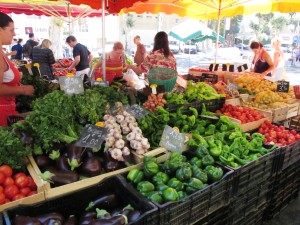African Peanut Stew
This recipe for Spicy African Peanut Stew is one of my favorite healthy dishes to make. It is gluten free, vegan, and very nutritious. It was recently featured in a recipe booklet my local Dietetic Association made for National Nutrition Month in March. You can modify it by adding chicken or different toppings and make it your own.
Here is the recipe as printed in “40 Healthy & Easy Recipes”
Spicy African Peanut Stew (Vegan)
Type of dish: Appetizer, Side or Entree
A little about the stew: This recipe quickly became a favorite of mine. I modified it a little from the original and made it my own. I cook it all fall and winter long. I like to think that it keeps me from getting sick and is very soothing when I do catch a cold. I also always go back to it when I am looking to lose a couple pounds or jump start a diet. It is quick to prepare (about 45 minutes total), vegan, full of nutrients, low in calories, high in fiber, and satisfies the sweet, salty, tangy craving all in one bowl. I often have a big bowl of it as my main meal. It can be served over brown or white rice, but I usually just top it with some chopped cilantro and a squeeze of lime. Chicken could also be added for meat eaters.
My substitution: I use organic ingredients whenever possible. I also use unsalted peanut butter, and don’t add extra salt. The canned tomatoes usually have added salt but low sodium or sodium free tomatoes could be substituted.
Ingredients:
2 Tbsp olive oil
1/3 cup No salt added crunchy peanut putter
2 28oz cans Organic diced tomatoes, do not drain juice
2 Tbsp hot diced green chiles (canned)
2 medium celery stalks chopped
1/2 of one medium white or red onion chopped
1 medium sweet potato cubed
2 medium carrots sliced
1 Tbsp minced garlic
1 Tbsp grated ginger
1 cup water
1/3 cup hot water
Recipe:
.In a medium sauce pan, heat 2 tbsp olive oil and add sliced carrots. Cover and let cook 5 minutes to begin to steam carrots.
. Add chopped celery, onion and sweet potato to carrots. Stir and allow to cook another 5-7 minutes covered.
. Add garlic and grated ginger, stir to incorporate and cover for 3 minutes
. Add cans of tomatoes, chiles and 1 cup of water. Let mixture come to a boil. Simmer for 15 minutes.
.In a separate bowl, combine 1/3 cup peanut butter to 1/3 cup hot water and break down with fork til combined and creamy. This prevents the peanut butter from clumping in the stew and allows it to break down more easily when added to the stew.
.Add peanut butter mixture to stew and stir. Simmer for another 5-10 minutes.
Stew should be an orange/red creamy color when done.
Top with chopped cilantro and squeeze of fresh lime once serving, if desired.
Enjoy!!
Nutrition breakdown:
Recipe makes six 1.5 cup servings
Per serving (1.5 cup)
Kcals: 190
Pro: 6g
Fat: 11g
CHO: 22g
Fiber: 6g
Na+: 548mg

















